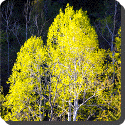 Aspens — Aspens are trees of the willow family and comprise a section of the poplar genus, Populus sect. Populus.
Aspens — Aspens are trees of the willow family and comprise a section of the poplar genus, Populus sect. Populus.
The five typical aspens are all native to cold regions with cool summers, in the far north of the Northern Hemisphere, extending south only at high altitudes in mountains. The White Poplar by contrast is native to much warmer regions, with hot, dry summers. They are all medium-sized deciduous trees reaching 15–25 m tall, exceptionally to 30 m.
Aspens (apart from the aberrant White Poplar) are distinguished by their nearly round leaves on mature trees, 9–16 cm diameter with irregular rounded teeth. They are carried on strongly flattened leaf stems, which enable the leaves to twist and flutter in the slightest of breezes. The juvenile leaves on young seedlings and root sprouts differ markedly from the adult leaves, nearly triangular, showing here the typical leaf shape of most other poplars; they are also often much larger, 13–26 cm long. The five typical aspens are distinguished from each other by leaf size and the size and spacing of the teeth on the adult leaves. White Poplar leaves differ in being deeply five-lobed, covered in thick white down, and having only a slightly flattened leaf stem.
All the aspens (including White Poplar) typically grow in large colonies derived from a single seedling, and spreading by means of root suckers; new stems in the colony may appear at up to 30–40 m from the parent tree. Each tree only lives for 40–150 years above ground, but the root system of the colony is long-lived, in some cases for many thousands of years, sending up new trunks as the older trunks die off above ground. For this reason it is considered to be an indicator of ancient woodlands. One such colony in Utah, given the nickname of “Pando”, is claimed to be 80,000 years old, making it possibly the oldest living colony. Some aspen colonies become very large with time, spreading about a metre per year, eventually covering many hectares. They are able to survive intense forest fires as the roots are below the heat of the fire, with new sprouts growing after the fire is out. However, aspens do not thrive very well in the shade, and it is difficult for aspen seedlings to grow in an already mature aspen stand. Fire indirectly benefits aspen trees, as it allows the saplings to flourish in open sunlight on account of the burned landscape. Lately aspen has increased its popularity in forestry, mostly because of its fast growth rate and ability to regenerate from sprouts, which makes the regeneration of the forest after harvesting much cheaper, as no planting or sowing is required.
 Kids Portal For Parents India Kids Network
Kids Portal For Parents India Kids Network






